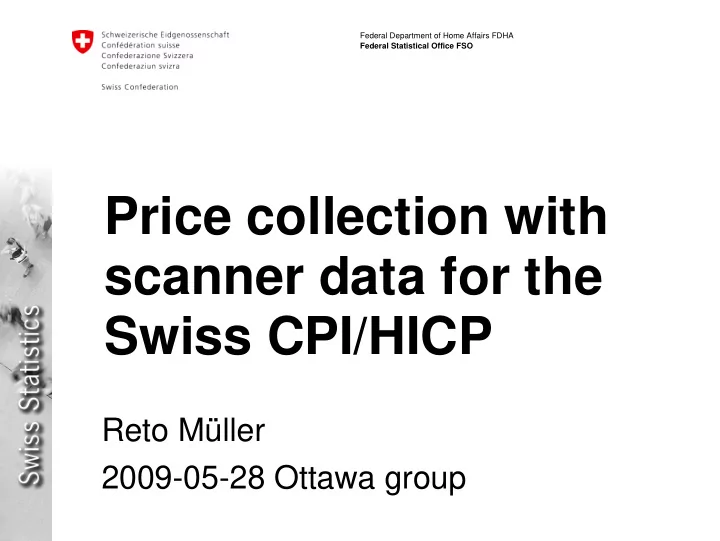

Federal Department of Home Affairs FDHA Federal Statistical Office FSO Price collection with scanner data for the Swiss CPI/HICP Reto Müller 2009-05-28 Ottawa group
Federal Department of Home Affairs FDHA Federal Statistical Office FSO Overview • First introduction of scanner data for CPI/HICP calculation in July 2008 for • food and near food (without non-food) • the largest retailer in Switzerland (> 25% market share for food) • Introduction of more retailers starting Jan 2010 (new software currently under development) Ottawa Group Meeting 2009 | Price collection with scanner data for the Swiss CPI/HICP 2 Reto Müller
Federal Department of Home Affairs FDHA Federal Statistical Office FSO Step by step proceeding (I) Due to the many methodical difficulties related to scanner data the FSO has chosen a step by step proceeding: • scanner data serve in a first step as an improvement of the existing price collection system (using current methods of index computation) • evaluation of alternative index formulas or different kinds of quality adjustments to follow in a second step • this allows the FSO to take immediate advantage of the most important benefits of scanner data without taking any major risks Ottawa Group Meeting 2009 | Price collection with scanner data for the Swiss CPI/HICP 3 Reto Müller
Federal Department of Home Affairs FDHA Federal Statistical Office FSO Step by step proceeding (II) System started with the same methods for index computation used without scanner data: Elementary indices : • Geometric mean • Unweighted price changes (BUT: average price per article of the first 14 days of each month!) Higher level indices: • Aggregation of elementary indices using weights from HBS (not scanner data) • Lowe chain index: Annual reweighting and year to year chaining (Dec.) on product group level Ottawa Group Meeting 2009 | Price collection with scanner data for the Swiss CPI/HICP 4 Reto Müller
Federal Department of Home Affairs FDHA Federal Statistical Office FSO Step by step proceeding (III) System also started with • the same methods for selecting and replacing items (quality adjustments) used without scanner data: • selection of a representative sample of goods (according to CPI basket) • items with highest turnover • one retail chain and a limited selection of product groups (food/near-food): • few assortment changes and quality adjustments • integration of more retailers and product groups step by step Ottawa Group Meeting 2009 | Price collection with scanner data for the Swiss CPI/HICP 5 Reto Müller
Federal Department of Home Affairs FDHA Federal Statistical Office FSO Advantages of scanner data using current methods (I) 1.) Increased data quality: • precise sampling method according to turnover • price collection during a period of two weeks instead of a single day • recording of all transactions including sales, promotions and other offers • scanner data usually include transactions from every single outlet nationwide (trad: sampling of stores) Ottawa Group Meeting 2009 | Price collection with scanner data for the Swiss CPI/HICP 6 Reto Müller
Federal Department of Home Affairs FDHA Federal Statistical Office FSO Advantages of scanner data using current methods (I) 2.) Reduced costs • Traditional price collection in the field is mainly done by a private market research institute on behalf of FSO 3.) Smaller burden of workload for the retail chains • Traditional price collectors take up time of retail stores’ staff Ottawa Group Meeting 2009 | Price collection with scanner data for the Swiss CPI/HICP 7 Reto Müller
Federal Department of Home Affairs FDHA Federal Statistical Office FSO Major challenges • Allocation of each article to the correct CPI position: Information is bought from a market research institute • Selection and replacement of items: Full automation is not possible with current methods of item selection and quality adjustment • Limited item descriptions for some product groups (difficult quality adjustments, especially non food) • Quantity discounts: Items temporarily sold in multiple units are often not identifiable as the same item without additional information • Receiving (donated) scanner data from retail chains Ottawa Group Meeting 2009 | Price collection with scanner data for the Swiss CPI/HICP 8 Reto Müller
Federal Department of Home Affairs FDHA Federal Statistical Office FSO Project planning (I) • Pilot project Web-based price collection software with largest retail chain: Finished July 2008 (software entered into production process) • Realization part 1 Software engineering (generic tool) for scanner data price collection of food / near-food product groups from every major retail chain in Switzerland • Jan 2010: Integration of first retail chain with new software • Until 2012: Integration of more retailers every 6 months Ottawa Group Meeting 2009 | Price collection with scanner data for the Swiss CPI/HICP 9 Reto Müller
Federal Department of Home Affairs FDHA Federal Statistical Office FSO Project planning (II) • Realization part 2 • Evaluation of alternative methods of quality adjustment/ (esp. implicit for more automation) and alternative index formulas / weighting methods • Integration of non-food groups • Planification tbd Ottawa Group Meeting 2009 | Price collection with scanner data for the Swiss CPI/HICP 10 Reto Müller
Federal Department of Home Affairs FDHA Federal Statistical Office FSO Thank you for your attention! Ottawa Group Meeting 2009 | Price collection with scanner data for the Swiss CPI/HICP 11 Reto Müller
Recommend
More recommend